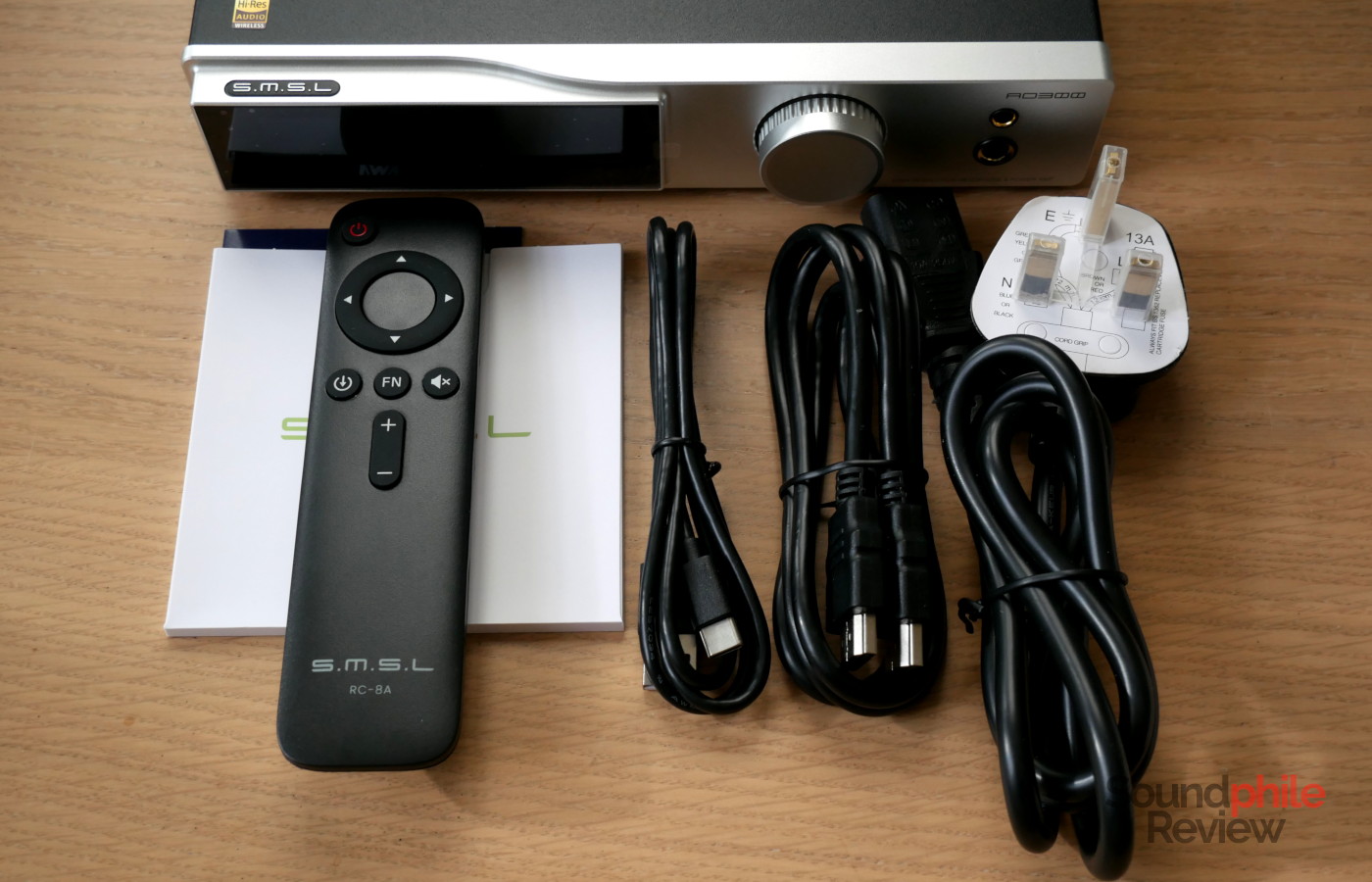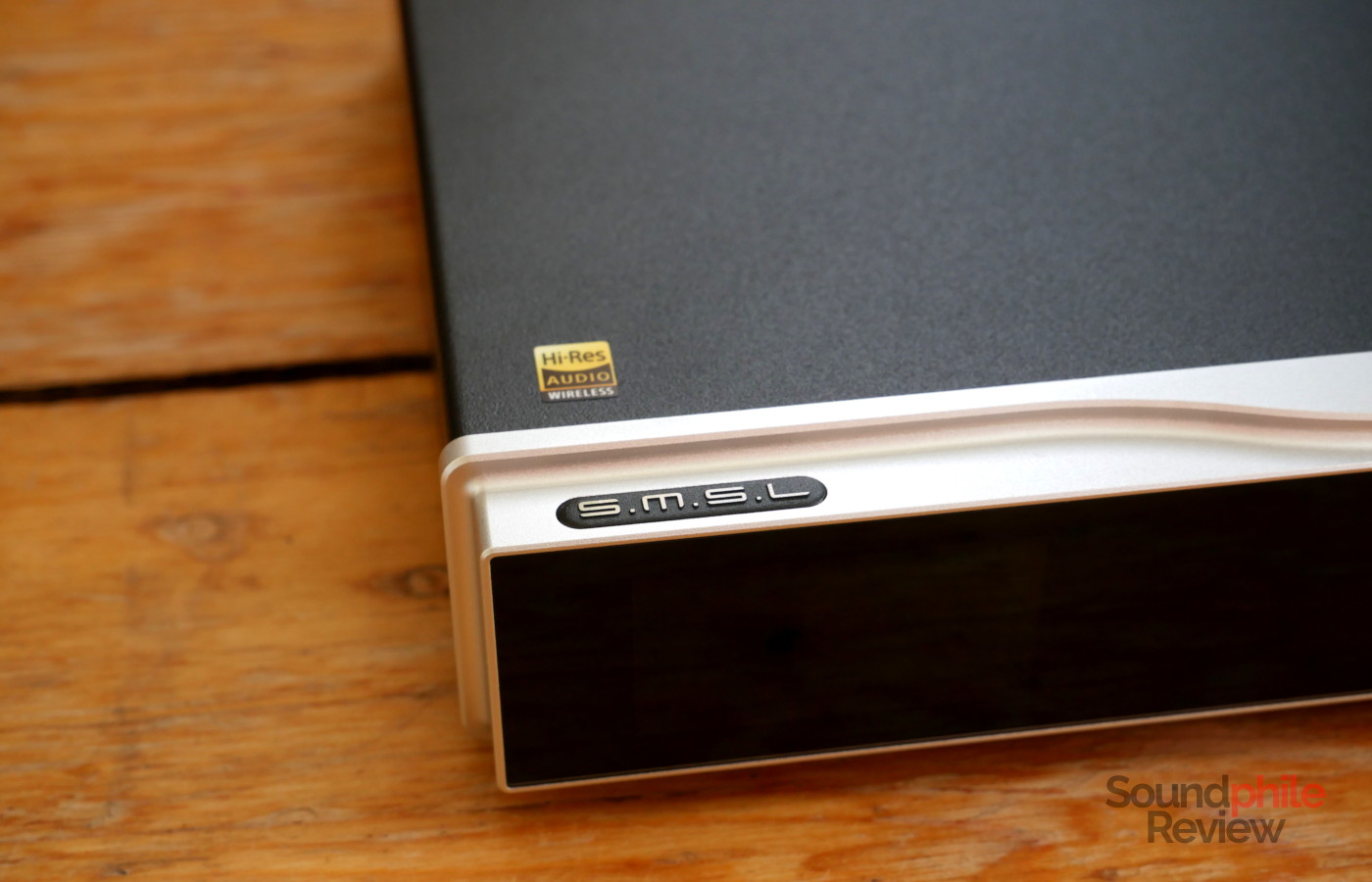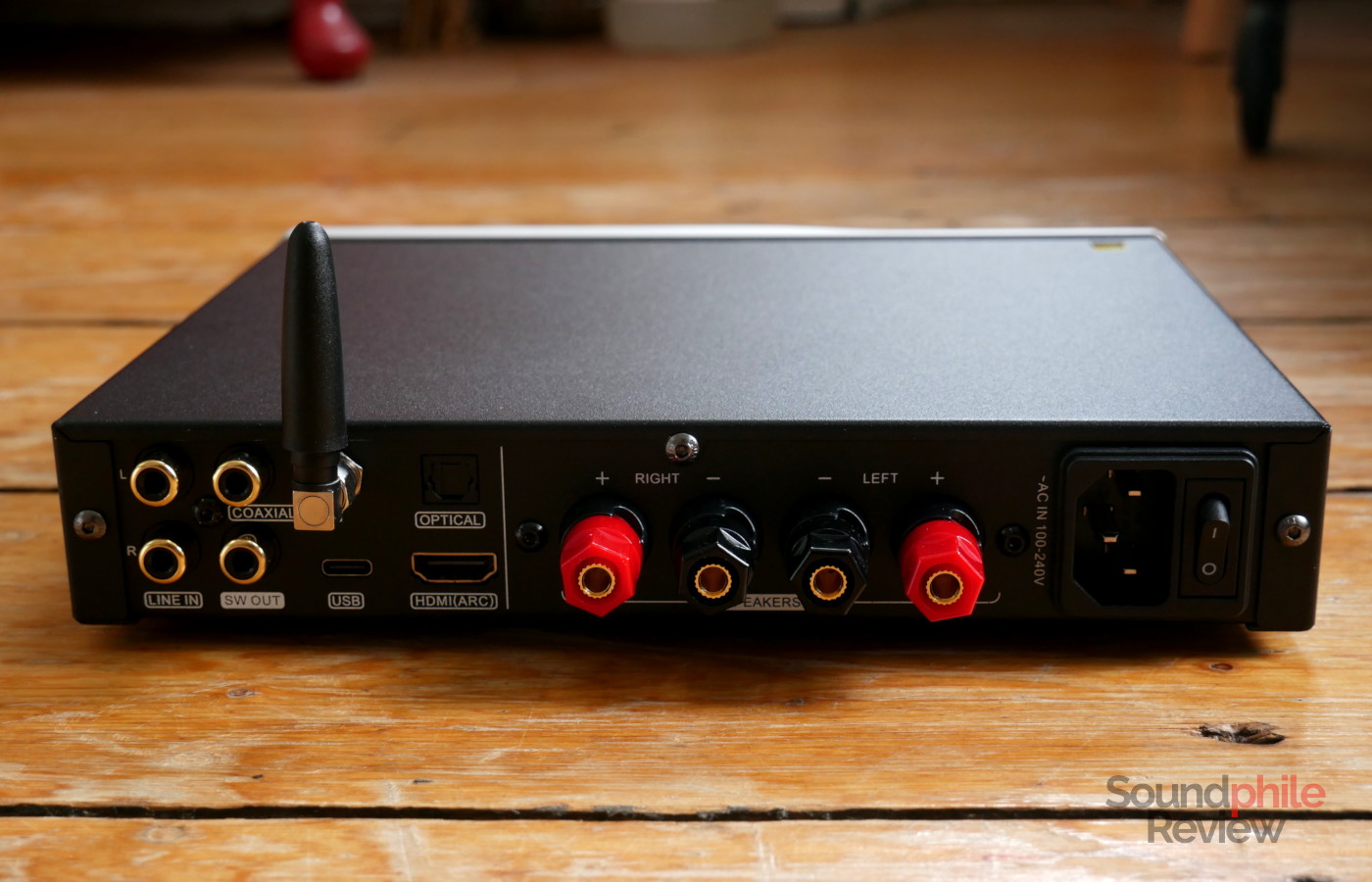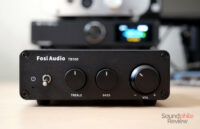The SMSL AO300 continues what we’ve already seen with the DO400, but brings it to the stereo amplification stage: it brings together a DAC, a stereo amplifier and a headphone amplifier, using the same design language as the DO400 and offering a lot of flexibility in the input department.
Disclaimer: I received a free unit from Aoshida Audio for the purpose of this review. They sell it for $289 ($262 as I am writing this).
TL;DR: recap
| Pros |
Cons |
| + Very well built
+ Lots of input options (including HDMI!) + Neutral sound signature + Lots of power + Well-done equalisation presets |
– The remote needs to be exactly in front of the amp |
Rating: 9.5/10
Packaging & Accessories

There’s not much in terms of accessories, as the AO300 comes with a power cable, a USB to USB-C cable, an HDMI cable (which is indeed a welcome addition!), a remote control and the manual.
Design & Build

SMSL adopted the same design language the company had already used for the DO400: the front has a “floating” screen on the left hand side, with an off-centre volume knob and the headphones outputs (plural: a 6.3 mm unbalanced jack and a 4.4 mm balanced jack) on the right hand side. The look is pretty unmistakably very modern, but it is understated enough it should feel right at home basically in any context – especially, I think, in the silver version. That colour is actually applied only to the front itself, while the rest of the unit stays black – a very good choice, in my opinion.

The back is where we find the input connectors as well as the speaker outputs. There’s the power switch, the power connector, the speaker outputs, an optical port, an HDMI port, the Bluetooth antenna, a USB-C port, a coaxial connector, a single RCA output for subwoofer and stereo RCA input.

Despite incorporating the power supply, the AO300 is relatively small (it is smaller than the DO400!) at just 219 x 185 x 42 mm. It is definitely smaller, and in particular less deep, than the AO200 MKII which I reviewed back in September.
Build quality is top-notch, as we’ve come to expect from SMSL, and the unit feels super solid and well put together.
The volume knob is actually a wheel, with small notches that help you get a good grip on it. It is a digital, stepped wheel which clicks on every step; it allows you to have precise measurement and it offers a bit of resistance, so you have to use a bit of force to actually turn it – which is a good thing.
Features & Specs

The SMSL AO300 is the first in the AO line, which comprises stereo amplifiers (I guess the “A” stands for “amplifier”, though I don’t know what the “O” stands for), to also sport an integrated DAC and headphone outputs (the AO200 also sported a DAC and USB input, but no headphone outputs). It is basically like a DO400, except it also features a speaker amplifier. This is the reason why it features not only stereo RCA input, but also a host of digital connections: there’s USB-C, which you can use with computers, tablets and smartphones; coaxial and optical; Bluetooth; and HDMI, which is especially useful to employ the AO300 as your only device if you want to get better audio from your TV. If your TV has HDMI ARC, you can use a single cable to connect it to the AO300 and get better audio for all devices connected to it – so not just the TV’s own audio, but also that from consoles, computers, DVD or Blu-Ray players and so on connected to it. In fairness, you can obtain the same result by using an optical cable, but with some TVs that prevents you from using the TV’s remote for adjusting the volume (e.g. LG TVs with webOS, like the one I have!); with HDMI ARC this is not an issue. You will still have to power on the amplifier separately from the TV, which is a bit of a shame – it would have been much more convenient to have it power on automatically with the TV!
The Bluetooth connection supports the SBC, AAC, aptX, aptX HD and LDAC codecs, so you have a wide variety of choices that should make it compatible with any source device.
SMSL AO300 |
| Input | RCA, Bluetooth, USB, optical, coaxial, HDMI ARC |
| Suitable speaker impedance | 2 – 8 Ω |
| Maximum output power | 165 W p.c. (4 Ω) 85 W p.c. (8 Ω) |
| Frequency response | N/A |
| THD+N (@1 kHz) | < 0.003% |
| SNR | > 107 dB |
| Crosstalk | 98 dB |
Despite being smaller than the AO200 MKII, and despite offering a headphone amplification stage as well, the AO300 manages to offer slightly more power (165 W vs 160 W at 4 Ω) as well as better overall specs. The amplifier chip for the speaker output is the same as the previous model, an Infineon MA5332MS, while the headphone output is managed directly by the DAC chip, a Cirrus Logic CS43131. Speaking of specifications, SMSL does not provide any in regards to the headphone amplifier. The official specifications for the DAC chip say that it is able to output 30 mW @ 32 Ω and 5 mW @ 600 Ω when using its own integrated headphone amplifier, but there are no indications whether SMSL used it or opted for dedicated headphone amplification.
The SMSL AO300 offers eight equalisation presets and five filters you can choose from.
The remote is the same as that provided with other recent devices by SMSL: it is made of plastic and it has buttons to turn on and off the unit, navigate through the menus with four directional arrows and one enter button, adjust volume as well as buttons to select input, output and mute mode. One note about the remote is that, contrarily to previous SMSL devices I have tested, it is extremely directional. Unless the remote is exactly in front of the AO300, it won’t work. While this is not a major issue, for obvious reasons, it is a minor annoyance.
Sound: SMSL AO300 as stereo amplifier
I tested the SMSL AO300 unit I got with a couple of Q Acoustics Concept 20 speakers.
SMSL has built itself a reputation as a company able to produce audio devices with great sound quality and the AO300 lives up to the expectations with a neutral sound signature which works well with virtually any speaker. The large power output is enough to drive most speakers with ease – it has no issues at all driving my Concept 20 speakers to very high volume while staying in the lower 20 range (out of 60). The soundstage is wide and deep, while imaging is highly accurate and instrument separation is superb.
In case you would like to change how your speakers sound, you can use the equalisation feature which allows you to set values for bass and treble between -10 and +10. There are then equalisation presets which are identical to those present on the AO200 MKII:
- Direct: this is the default and it means no equalisation is applied;
- Tone: this profile appears to apply minor adjustments to sound as I cannot hear any significant difference when it is selected.
- SDB: SDB seems to boost bass like the Bass setting, but it also adds emphasis to the treble and the mids. It appears to boost all frequencies by a bit, though it combines the Bass setting with a similar one for treble (though of less intensity). The result is that it makes music sound more “enveloping” in way, and surely more entertaining than the default profile. I find it quite useful when I listen to music at a low volume.
- Bass: it boosts bass by about 4 dB, making it significantly more present in the mix without exceeding. The boost starts at 20 Hz, which is useful in case of low sub-bass response from your speakers, and goes progressively down in intensity.
- Super Bass: this is a more extreme version of the previous profile, with a 7 dB boost which starts at 20 Hz and progressively slopes down as frequency increases. Use with caution!
- Rock: this profile boosts bass while also adding some additional emphasis on mids and treble. It sounds a bit like a lower-intensity SDB.
- Soft: this setting is more difficult to place than the others, but it appears to boost the midrange as well as the treble slightly.
- Clear: this one seems to boost midrange and treble by a little bit, but it’s quite a minor difference.
Sound: SMSL AO300 as headphone amplifier
I tested the AO300 using various headphones, including the AFUL MagicOne, the HiFiMAN HE-560, the OneOdio Monitor 80 and the Sennheiser HD 6XX.
The AO300 provides a very clean background, so there is no hiss nor hum, even when using sensitive earphones. On the other end of the impedance spectrum, there is enough power to drive even demanding headphones like the Monitor 80 or the HD6XX to very high volume levels. The HE-560 are similarly driven to high volume despite having low sensitivity.
In terms of sound, the AO300 delivers a dead-neutral tuning which couples well with any headphones. The same EQ adjustments available for the speakers are available for the headphones, too, so you can change how they sound easily (and independently of source devices, too!).
Final Thoughts
The SMSL AO300 is a superb device which works wonderfully well as a desktop amplifier due to offering both speakers and headphones amplification, but it works fantastically in the living room as well for the same reason. Its neutral signature on all outputs makes it a fantastic pairing with any speakers or headphones you have, and the power available in both cases is enough to power virtually anything with ease. To top this off, build quality is fantastic and the amount of input options makes it a very flexible device which is hard not to recommend wholeheartedly.
One final note goes to compliment SMSL and Aoshida Audio due to the way they managed a minor issue I found. I asked my contact at Aoshida about it, and she asked the engineers in SMSL. After a bit of back-and-forth, in which I sent a video explaining the issue, the engineers produced a new firmware that fixed the issue entirely. All of this happened in the space of a week! New units come with the new firmware, too.









Grazie per la recensione, ne ho comprato uno appena letta. Ciao.
A very precise and comforting review. Truly supports my experience with the 300.
An amazing product for the price!
You didnt compare ao300 with ao200 mk2 soundwise ? Do they sound similar and which one sounds better to you ? I need amp that can handle my Ushers x719 in my bedroom mostly used to watch tv and movies . I tried it with 105w denon old receiver and they sounded like crap , no bass even with bass setting all the way up . Then I tried my anthem mrx 720 and Ushers are amazing but I want something smaller and 2 channel in my bedroom without spending fortune .
Hello Marek!
There’s surprisingly little to say on the sound differences. I could actually hear none with my setup. The difference in power output is minimal (just 5 W p.c. more) and considering both devices use the same amplifier chip and a very similar overall setup, I would say that the differentiating bit is just the fact that the AO300 has headphone outputs as well.
Considering the nominal impedance of your Usher X719 is 8 Ω and that they’re rated for 80 W maximum, I think both the AO300 and the AO200 MKII could work in your case; it depends on whether you want/need a headphone amplifier as well.
I hope this helps!
Anche io l’ho appena acquistato. And I cross my fingers for my first D class amp…
You might want to amend your section on the “Tone” setting.
You said “appears to apply minor adjustments to sound as I cannot hear any significant difference when it is selected”.
What it actually seems to do is allow you to switch between the presets, and the bass and treble you can manually adjust. They probably should label it “custom” instead of “tone”.
Thanks for a good review which I found helpful before purchasing my AO300. I agree with much of what you say although I haven’t dabbled with all the settings yet. The one thing I would disagree with is concerning the remote and having to be right in front of the unit. I find that I can control my AO300 from across the room at quite an acute angle – although it’s hard to read the display at that distance. Once sat down I can control the volume which is mainly what I do. Anything else then I have to be close to the unit to read the display. Perhaps they have modified the remote? Overall a great little amp.